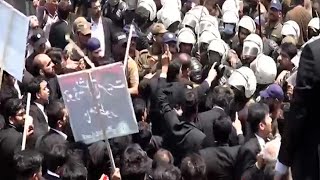ISLAMABAD: The Pakistan Telecommunication Authority (PTA) has drafted Licensing Framework for Terrestrial Internet of Things (IoT) services, emphasising to elaborate on the requirements and guidelines for provision of IoT services in un-licensed frequency bands.
The objective of the framework is to provide a regulatory guideline for the industry, to enable the development of IoT/M2M eco-system, either through a list of un-licensed/shared bands may be used for Low Power Wide Area Networks (LPWAN), on non-interference and non-protection basis, or through exclusively licensed frequency bands, stated the PTA.
The authority stated that considering the international trends and insight of the government, a need was felt to formulate a regulatory framework elaborating requirements for developments of IoT ecosystem in licensed as well as unlicensed bands in the country.
Most of the IoT applications can be realised in radio frequency bands including cellular band(s), internationally harmonised bands for Short Range Devices and ISM bands etc. Each band, depending upon its characteristics, has its own use case.
Therefore, IoT licensing framework for service provisioning is, principally, classified according to the frequency bands involved for service provisioning, stated as; i) IoT services provided through exclusively assigned/licensed frequency bands; ii) IoT services provided through shared frequency/ un-licensed frequency bands, further categorised as: a) IoT services through Short Range Devices-Bands (SRD-bands) and/or Ultra-Wide Band (UWB) b) IoT Services under Class LPWAN License/ Authorization.
The draft stated that cellular and other licensees may provide IoT services through their exclusively licensed frequencies under respective license conditions, and/or any other conditions as specified by the authority from time to time.
Further Mission Critical Services shall be offered through exclusively licensed frequency bands under the terms and conditions of such license or any other conditions as specified by the authority.
It further stated that the radio frequency spectrum specified for such use cases shall be exempted from licensing, provided its operations are within approved technical standards/limits as specified in the respective framework for SRD.
The communication remains mostly indoor, and/or effective within an outdoor range of 100m, and not connected directly to any public switched telecom network. The SRD use shall require Type Approval (TA) as a mandatory requirement from authority, pursuant to prevailing Type Approval Regulations. The draft proposed that the licensee of LPWAN shall provide the IoT-specific connectivity in a given area of service (AoS), through the frequency bands as specified, with strict compliance to respective power limits.
Further it shall transport the backend traffic generated through LPWAN network, to the cloud/internet or to servers geographically separated from LPWAN base station, through a PTA licensed Local Access Providers.
The duration of license shall be for five years, renewable for other term(s) consistent with the policy of the federal government.
Exclusively assigned/ already licensed frequency bands shall be governed as per the respective license conditions, and/or any other conditions as specified by the authority from time to time.
Exclusive allocations for IoTs in any other frequency band shall be dealt on case-to-case basis, in the bands as specified by the government from time to time.
The shared/un-licensed frequency bands as referred in SRD Framework for LPWAN shall be used on secondary basis i.e. the networks operating in these bands shall not cause interference to other authorised primary radio communication services and shared/non-exclusive basis i.e. the users of these networks shall not ask any protection from interference caused by the current or future primary/secondary users and be able to tolerate any interference caused by other radio-communication services, electrical or electronic equipment.
On occasion of interference to primary services, a user of an un-licensed frequency bands shall stop the use with immediate effect, on direction of the authority.
It further stated that the licensee shall not install or connect, or permit the installation or connection of, any Terminal Equipment unless the Terminal Equipment is (a) type approved, or otherwise permitted by the Authority and (b) type approved by a recognized telecommunication equipment type approval agency or a recognized telecommunication equipment testing laboratory in a member country of the Organization of Economic Cooperation and Development (OECD).
The Licensee shall not install or connect, or permit the installation or connection of, any Terminal Equipment or type of Terminal Equipment prohibited by the Authority.
All the equipment used to provide IoT services must comply with Type Approval Regulations issued by the Authority from time to time.
The devices (Sensors, actuators, aggregators, appliances etc), used in deployment of network under LPWAN license, shall comply with the International Commission on Non-Ionizing Radiation Protection (ICNIRP) guidelines for limiting exposure to time varying electric, magnetic, and electromagnetic fields.
The numbering range shall be used as per the National Numbering Plan.
“Number Allocation & Administration Regulations, 2018” shall apply including amendments/modifications made thereto, by the Authority, from time to time.
The suitable IP addressing is permissible; however, migration to IPv6 is highly encouraged. The licensees providing the IoT services must save and maintain the data of at least 12 months, for provision to the authority, as and when requested.
Licensee must report the data breaches (if any) to the authority within five working days, after becoming aware of such a breach.
Copyright Business Recorder, 2021























Comments
Comments are closed.